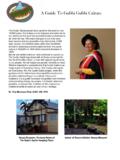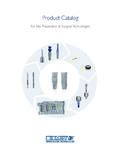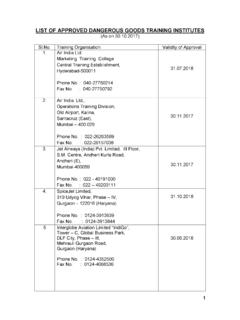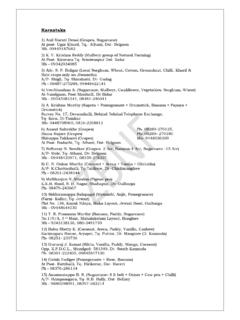Transcription of Mechanical Measurements And Metrology Laboratory
1 QMP D/F. Channabasaveshwara Institute of Technology (An ISO 9001:2008 Certified Institution). NH 206 ( Road), gubbi , Tumkur 572 216. Karnataka. Department of Mechanical Engineering Mechanical Measurements And Metrology Laboratory 10 MEL47B. - IV Semester Lab Manual 2015-16. Name : _____. USN : _____. Batch : _____ Section : _____. Channabasaveshwara Institute of Technology (An ISO 9001:2008 Certified Institution). NH 206 ( Road), gubbi , Tumkur 572 216. Karnataka. Department of Mechanical Engineering Mechanical Measurements and Metrology Lab Manual Version February 2016. Prepared by: Reviewed by: Mr. Chikkannaswamy V M & Mr. Ravi N S. Mr. Lokesh N Assistant Professor Assistant Professors Approved by: Head of the Department Department of Mechanical Engineering Channabasaveshwara Institute of Technology NH 206 ( Road), gubbi , Tumkur 572 216. Karnataka. Department of Mechanical Engineering Mechanical Measurements AND Metrology Laboratory . Subject Code: 10 MEL37B / 47B IA Marks: 25.
2 Hours/Week: 03 Exam Hours: 03. Total Hours: 48 Exam Marks: 50. PART-A: Mechanical Measurements . 1. Calibration of Pressure Gauge 2. Calibration of Thermocouple 3. Calibration of LVDT. 4. Calibration of Load cell 5. Determination of modulus of elasticity of a mild steel specimen using strain gauges. PART-B: Metrology . 1. Measurements using Optical Projector / Toolmaker Microscope. 2. Measurement of angle using Sine Center / Sine bar / bevel protractor 3. Measurement of alignment using Autocollimator / Roller set 4. Measurement of cutting tool forces using a) Lathe tool Dynamometer b) Drill tool Dynamometer. 5. Measurement of Screw threads Parameters using Two wire or Three-wire method. 6. Measurements of Surface roughness, Using Tally Surf/ Mechanical Comparator 7. Measurement of gear tooth profile using gear tooth vernier /Gear tooth micrometer 8. Calibration of Micrometer using slip gauges 9. Measurement using Optical Flats Scheme of Examination ONE question from part-A: 20 Marks ONE question from part-B: 20 Marks Viva -Voice: 10 Marks Total: 50 Marks INDEX PAGE.
3 Record Marks Manual Marks Date (Max . 25). (Student). (Max. 10). Signature Signature (Faculty). Sl. No Name of the Experiment Submission Conduction Repetition of Record Average Note: If the student fails to attend the regular lab, the experiment has to be completed in the same week. Then the manual/observation and record will be evaluated for 50% of maximum marks. OBJECTIVES. The objectives of Mechanical Measurements & Metrology lab is To demonstrate the theoretical concepts taught in Mechanical Measurements & Metrology . To understand and use various measuring tools. To understand calibration of various measuring devices. OUTCOMES. The expected outcome of Mechanical Measurements & Metrology lab is that the students will be able To understand the basic measurement units and able to calibrate various measuring devices. To express error and correction factors of various measuring devices. To use measuring tools such as Sine Bar, Sine Center, Bevel Protractor, Tool Maker Microscope, Gear Tooth Micrometer, Optical Flats etc.
4 General instructions to the students Laboratory uniform, shoes & safety glasses are compulsory in the lab. Do not touch anything with which you are not completely familiar. Carelessness may not only break the valuable equipment in the lab but may also cause serious injury to you and others in the lab. Please follow instructions precisely as instructed by your supervisor. Do not start the experiment unless your setup is verified & approved by your supervisor. Do not leave the experiments unattended while in progress. Do not crowd around the equipment's & run inside the Laboratory . During experiments material may fail and disperse, please wear safety glasses and maintain a safe distance from the experiment. If any part of the equipment fails while being used, report it immediately to your supervisor. Never try to fix the problem yourself because you could further damage the equipment and harm yourself and others in the lab. Keep the work area clear of all materials except those needed for your work and cleanup after your work.
5 CONTENTS. Expt. Title of the Experiment Page No. No. PART A. 1 Calibration of Pressure Gauge 1. 2 Calibration of Thermocouple 5. 3 Calibration of LVDT 13. 4 Calibration of Load cell 17. 5 Determination of modulus of elasticity of a mild steel specimen using 21. strain gauges PART B. 6 Measurement of thread parameters using Optical Projector / Toolmaker 31. Microscope 7A Measurement of angle using Sine center 35. 7B Measurement of angle using Sine bar 39. 7C Measurement of angle using bevel protractor 43. 8 Measurement of alignment using Autocollimator / Roller set 47. 9A Measurement of cutting tool forces using Lathe tool Dynamometer 51. 9B Measurement of torque & thrust force using Drill tool Dynamometer. 55. 10 Measurement of Screw thread parameters using two wire or Three-wire 59. method 11A Measurements of Surface roughness using Taly Surf 71. 11 B Measurements of Surface roughness using Mechanical Comparator 73. 12 Measurement of gear tooth profile using gear tooth vernier /Gear tooth 77.
6 Micrometer 13 Calibration of Micrometer using slip gauges 81. 14 Measurement of surface flatness using Optical Flats 85. ADDITIONAL EXPERIMENTS. 15 Calibration of vernier caliper & measurement of the given component 89. 16 Power measurement using Rope brake dynamometer 93. VIVA QUESTIONS AND ANSWERS 95. Mechanical Measurements & Metrology Laboratory (10 MEL47B) 2015-16. EXPERIMENTAL SET UP FOR PRESSURE GAUGE EXPERIMENT. Specifications: Capacity : 10 kg / cm2. Type : Strain gauge type. Sensing Element : Resistances strain gauges. Over Load : 10 % rated capacity. Operating Temp : 100 C to 500 C. Excitation : 10 volts D C. Resistance in ohm s : 350 Ohms typical Department of ME, CIT, gubbi Page No. 1. Mechanical Measurements & Metrology Laboratory (10 MEL47B) 2015-16. PART - A. Experiment No: 1 Date: CALIBRATION OF PRESSURE GAUGE. Aim: To calibrate the given pressure gauge Apparatus: Pressure cell / sensor/ gauge, Dial type pressure cell indicator, Digital pressure Indicator Theory: Many techniques have been developed for the measurement of pressure and vacuum.
7 Instruments used to measure pressure are called pressure gauges or vacuum gauges. A 'manometer' is an instrument that uses a column of liquid to measure pressure, although the term is often used nowadays to mean any pressure measuring instrument. A pressure sensor / gauges measures pressure, typically of gases or liquids. Pressure is an expression of the force required to stop a fluid from expanding, and is usually stated in terms of force per unit area. A pressure sensor usually acts as a transducer; it generates a signal as a function of the pressure imposed. Pressure sensors are used for control and monitoring in thousands of everyday applications. Pressure sensors can also be used to indirectly measure other variables such as fluid/gas flow, speed, water level, and altitude. Pressure sensors can alternatively be called pressure transducers, pressure transmitters, pressure senders, pressure indicators, piezometers and manometers, among other names. Procedure: 1.
8 Make sure that dead weight pressure tester is filled with oil. To fill oil, fill the oil fully in the oil cup provided. Move the plunger to and fro so that all the air inside the reservoir will be filled with oil completely. 2. Connect the pressure cell to the pressure indicator through given cable. 3. Connect the instrument to mains , 230 volts power supply and switch on the instrument. 4. Check up the dead weight pressure tester plunger is to the extreme end so that there should not be any load or pressure on the piston. 5. Now adjust the zero point of the indicator, to indicate zero. 6. Apply the load of 10kg on the piston. 7. Move the plunger to apply pressure on the piston. When applied pressure reaches 10 kg/cm2, piston will start moving up. 8. Now read the pressure gauge reading and adjust the cal pot of the indicator to same pressure, as the analog reading. Now the given pressure cell is calculated. 9. Release the pressure fully by rotating the plunger.
9 Department of ME, CIT, gubbi Page No. 2. Mechanical Measurements & Metrology Laboratory (10 MEL47B) 2015-16. Tabular Column: Pressure shown in Actual Pressure % Error SL digital indicator Error (Pa) Pi Pa x 100. No. (Pi ) Pi Pa ( kg/cm2) Pa (kg/cm2). 1. 2. 3. 4. 5. 6. 7. 8. 9. 10. Department of ME, CIT, gubbi Page No. 3. Mechanical Measurements & Metrology Laboratory (10 MEL47B) 2015-16. 10. Load the piston by one kg; apply the pressure by rotating the plunger. At a Pressure of one kg /cm2, piston starts lifting up. Note down the reading. 11. Repeat the experiment for different loads on the piston step by step, and note down the readings of dial gauge and pressure indicator, simultaneously in every step. 12. Calculate the percentage error and plot the graph. Calculation: % Error = Indicated Pressure Actual Pressure X 100. Actual Pressure Plot the Graphs as follows: 1. Indicated Pressure v/s Actual Pressure 2. Indicated Pressure v/s Percentage error Applications: Pressure gauges are used for variety of industrial and application-specific pressure- monitoring applications.
10 Their uses include visual monitoring of air & gas pressure for compressors, vacuum equipment, process lines & specialty tank applications such as medical gas cylinders & fire extinguishers. Fluid pressure industrial hydraulic circuits. Measurement of steam pressure in power plants & boilers. Measurement of pressure in large pumping stations/ water works/ or minor/major irrigations. Results: Finally the pressure gauge has been calibrated. Department of ME, CIT, gubbi Page No. 4. Mechanical Measurements & Metrology Laboratory (10 MEL47B) 2015-16. EXPERIMENTAL SET UP FOR THERMOCOUPLE EXPERIMENT. Department of ME, CIT, gubbi Page No. 5. Mechanical Measurements & Metrology Laboratory (10 MEL47B) 2015-16. Experiment No. 2: Date: CALIBRATION OF THERMO COUPLE. Aim: To calibrate the given thermo couple using Resistance thermometer (RTD). Apparatus: Thermocouple, RTD, Digital temperature Indicator, Water bath Theory: Temperature measurement is the most common and important measurement in controlling any process.









